Page 460 of 514
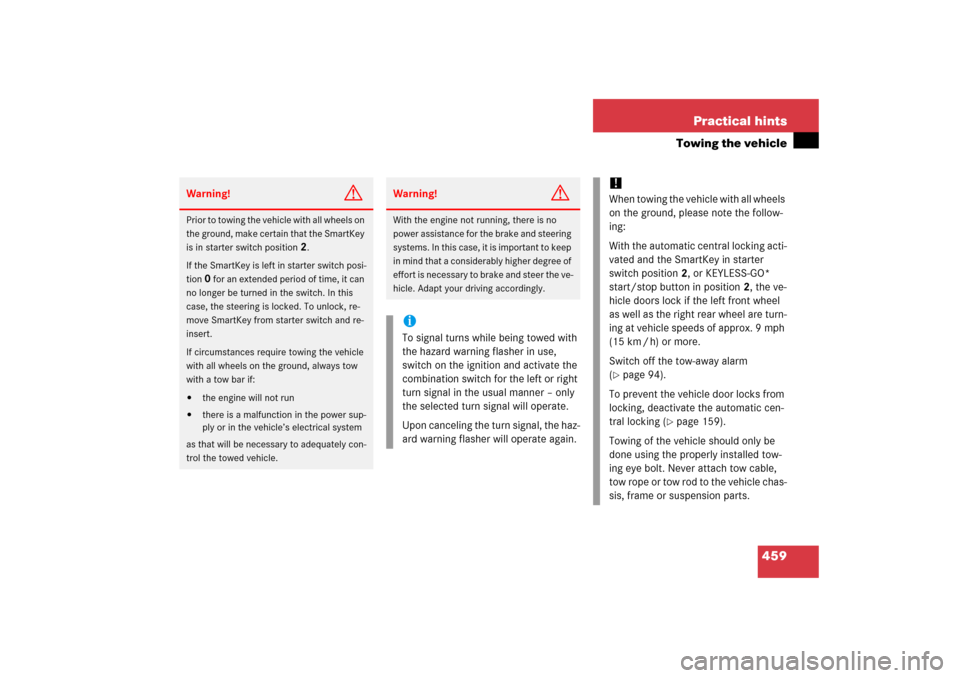
459 Practical hints
Towing the vehicle
Warning!
G
Prior to towing the vehicle with all wheels on
the ground, make certain that the SmartKey
is in starter switch position
2.
If the SmartKey is left in starter switch posi-
tion
0 for an extended period of time, it can
no longer be turned in the switch. In this
case, the steering is locked. To unlock, re-
move SmartKey from starter switch and re-
insert.
If circumstances require towing the vehicle
with all wheels on the ground, always tow
with a tow bar if:
�
the engine will not run
�
there is a malfunction in the power sup-
ply or in the vehicle’s electrical system
as that will be necessary to adequately con-
trol the towed vehicle.
Warning!
G
With the engine not running, there is no
power assistance for the brake and steering
systems. In this case, it is important to keep
in mind that a considerably higher degree of
effort is necessary to brake and steer the ve-
hicle. Adapt your driving accordingly.iTo signal turns while being towed with
the hazard warning flasher in use,
switch on the ignition and activate the
combination switch for the left or right
turn signal in the usual manner – only
the selected turn signal will operate.
Upon canceling the turn signal, the haz-
ard warning flasher will operate again.
!When towing the vehicle with all wheels
on the ground, please note the follow-
ing:
With the automatic central locking acti-
vated and the SmartKey in starter
switch position2, or KEYLESS-GO*
start/stop button in position2, the ve-
hicle doors lock if the left front wheel
as well as the right rear wheel are turn-
ing at vehicle speeds of approx. 9 mph
(15 km / h) or more.
Switch off the tow-away alarm
(�page 94).
To prevent the vehicle door locks from
locking, deactivate the automatic cen-
tral locking (
�page 159).
Towing of the vehicle should only be
done using the properly installed tow-
ing eye bolt. Never attach tow cable,
tow rope or tow rod to the vehicle chas-
sis, frame or suspension parts.
Page 463 of 514
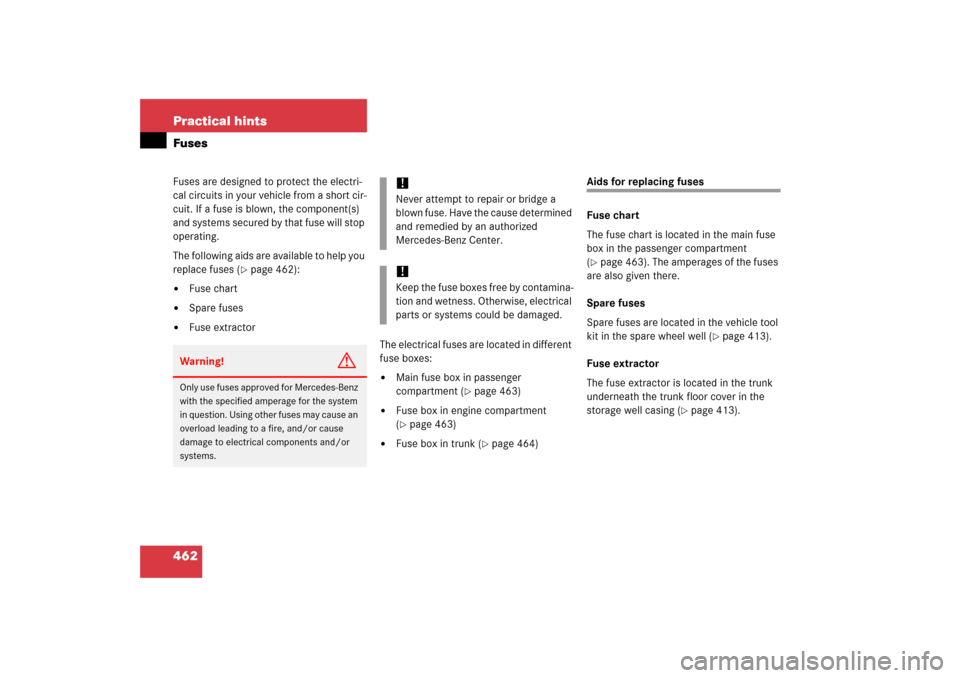
462 Practical hintsFusesFuses are designed to protect the electri-
cal circuits in your vehicle from a short cir-
cuit. If a fuse is blown, the component(s)
and systems secured by that fuse will stop
operating.
The following aids are available to help you
replace fuses (
�page 462):
�
Fuse chart
�
Spare fuses
�
Fuse extractor
The electrical fuses are located in different
fuse boxes:
�
Main fuse box in passenger
compartment (
�page 463)
�
Fuse box in engine compartment
(�page 463)
�
Fuse box in trunk (
�page 464)
Aids for replacing fuses
Fuse chart
The fuse chart is located in the main fuse
box in the passenger compartment
(�page 463). The amperages of the fuses
are also given there.
Spare fuses
Spare fuses are located in the vehicle tool
kit in the spare wheel well (
�page 413).
Fuse extractor
The fuse extractor is located in the trunk
underneath the trunk floor cover in the
storage well casing (
�page 413).
Warning!
G
Only use fuses approved for Mercedes-Benz
with the specified amperage for the system
in question. Using other fuses may cause an
overload leading to a fire, and/or cause
damage to electrical components and/or
systems.
!Never attempt to repair or bridge a
blown fuse. Have the cause determined
and remedied by an authorized
Mercedes-Benz Center.!Keep the fuse boxes free by contamina-
tion and wetness. Otherwise, electrical
parts or systems could be damaged.
Page 464 of 514
463 Practical hintsFuses
Mainfuse box in passenger compartment
The main fuse box is located in the passen-
ger compartment on the driver’s side of
the cockpit.
1Main fuse box coverOpening fuse box
�
Open the driver’s door.
�
Insert flat, blunt object as a lever into
the edge of the fuse box cover1 at
the position indicated by the arrow.
�
Loosen fuse box cover1 from cockpit
using lever.
�
Using your hands, remove fuse box
cover1 rearward.
Closing fuse box
�
Attach fuse box cover1 in the front.
�
Fold fuse box cover1 in until it
engages.
Fuse box in engine compartment
The fuse box is located in the engine com-
partment on the driver’s side.
1Cover
2Screw
3Retainer
Removing cover�
Twist screws2 90° counterclock-
wise.
�
Lift the rear of cover1.
�
Slide out retainer3 and remove
cover1 by pulling towards front.
!Do not use sharp objects such as a
screw driver to open the fuse box
cover1 in the cockpit, as this could
damage it.
Page 466 of 514
465 Technical data
Parts service
Warranty coverage
Identification labels
Layout of poly-V-belt drive
Engine
Rims and tires
Electrical system
Main dimensions and weights
Fuels, coolants, lubricants, etc.
Page 469 of 514
468 Technical dataIdentification labels1Certification label (includes
Paintwork code)2Vehicle Identification Number (VIN)3Emission control information label,
includes both federal and California
certification exhaust emission
standards
4Vacuum line routing diagram label
5VIN, visible (lower edge of windshield)
6Engine number (engraved on engine)
iWhen ordering parts, please specify ve-
hicle identification and engine
numbers.
Page 471 of 514
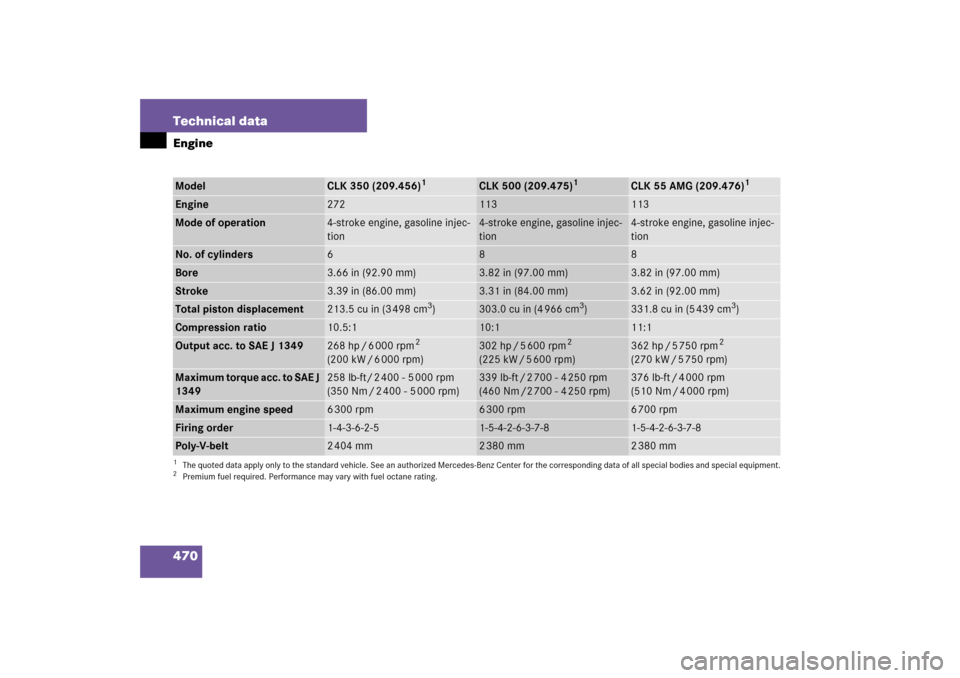
470 Technical dataEngineModel
CLK 350 (209.456)
1
1The quoted data apply only to the standard vehicle. See an authorized Mercedes-Benz Center for the corresponding data of all special bodies and special equipment.
CLK 500 (209.475)
1
CLK 55 AMG (209.476)
1
Engine
272
113
113
Mode of operation
4-stroke engine, gasoline injec-
tion
4-stroke engine, gasoline injec-
tion
4-stroke engine, gasoline injec-
tion
No. of cylinders
6
8
8
Bore
3.66 in (92.90 mm)
3.82 in (97.00 mm)
3.82 in (97.00 mm)
Stroke
3.39 in (86.00 mm)
3.31 in (84.00 mm)
3.62 in (92.00 mm)
Total piston displacement
213.5cuin (3498cm
3)
303.0 cu in (4 966 cm
3)
331.8 cu in (5 439 cm
3)
Compression ratio
10.5:1
10:1
11:1
Output acc. to SAE J 1349
268 hp / 6 000 rpm
2
(200 kW / 6 000 rpm)
2Premium fuel required. Performance may vary with fuel octane rating.
302 hp / 5 600 rpm
2
(225 kW / 5 600 rpm)
362 hp / 5 750 rpm
2
(270 kW / 5 750 rpm)
Maximum torque acc. to SAE J
1349
258lb-ft/2400-5000rpm
(350 Nm / 2 400 - 5 000 rpm)
339 lb-ft / 2 700 - 4 250 rpm
(460 Nm /2 700 - 4 250 rpm)
376lb-ft/4000rpm
(510 Nm / 4 000 rpm)
Maximum engine speed
6 300 rpm
6 300 rpm
6 700 rpm
Firing order
1-4-3-6-2-5
1-5-4-2-6-3-7-8
1-5-4-2-6-3-7-8
Poly-V-belt
2 404 mm
2 380 mm
2 380 mm
Page 480 of 514
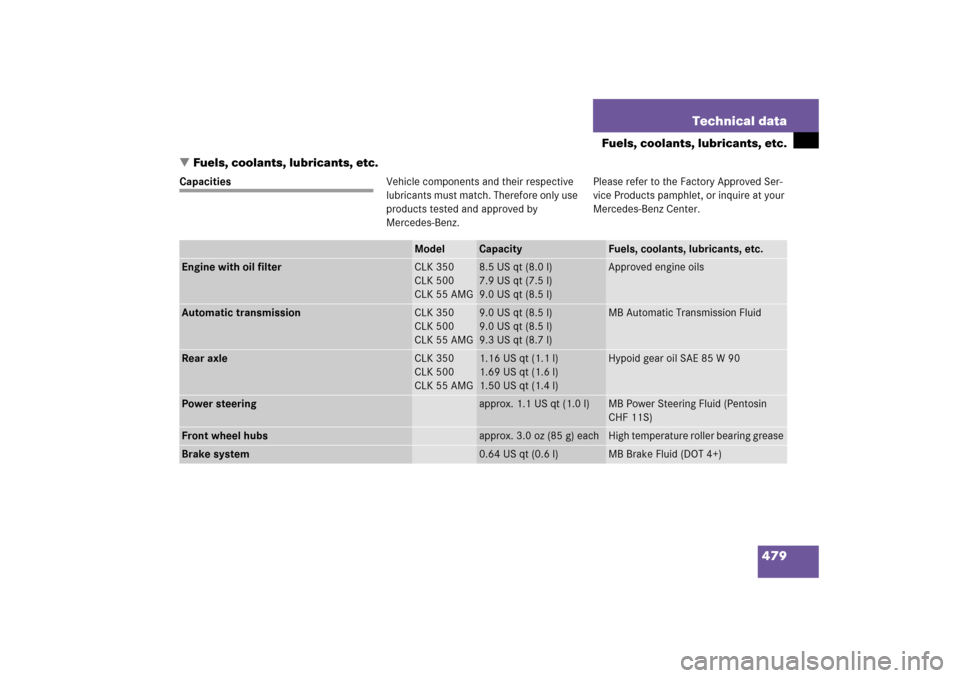
479 Technical data
Fuels, coolants, lubricants, etc.
�Fuels, coolants, lubricants, etc.
CapacitiesVehicle components and their respective
lubricants must match. Therefore only use
products tested and approved by
Mercedes-Benz.Please refer to the Factory Approved Ser-
vice Products pamphlet, or inquire at your
Mercedes-Benz Center.
Model
Capacity
Fuels, coolants, lubricants, etc.
Engine with oil filter
CLK 350
CLK 500
CLK 55 AMG
8.5 US qt (8.0 l)
7.9 US qt (7.5 l)
9.0 US qt (8.5 l)
Approved engine oils
Automatic transmission
CLK 350
CLK 500
CLK 55 AMG
9.0 US qt (8.5 l)
9.0 US qt (8.5 l)
9.3 US qt (8.7 l)
MB Automatic Transmission Fluid
Rear axle
CLK 350
CLK 500
CLK 55 AMG
1.16 US qt (1.1 l)
1.69 US qt (1.6 l)
1.50 US qt (1.4 l)
Hypoid gear oil SAE 85 W 90
Power steering
approx. 1.1 US qt (1.0 l)
MB Power Steering Fluid (Pentosin
CHF 11S)
Front wheel hubs
approx. 3.0 oz (85 g) each
High temperature roller bearing grease
Brake system
0.64 US qt (0.6 l)
MB Brake Fluid (DOT 4+)
Page 482 of 514
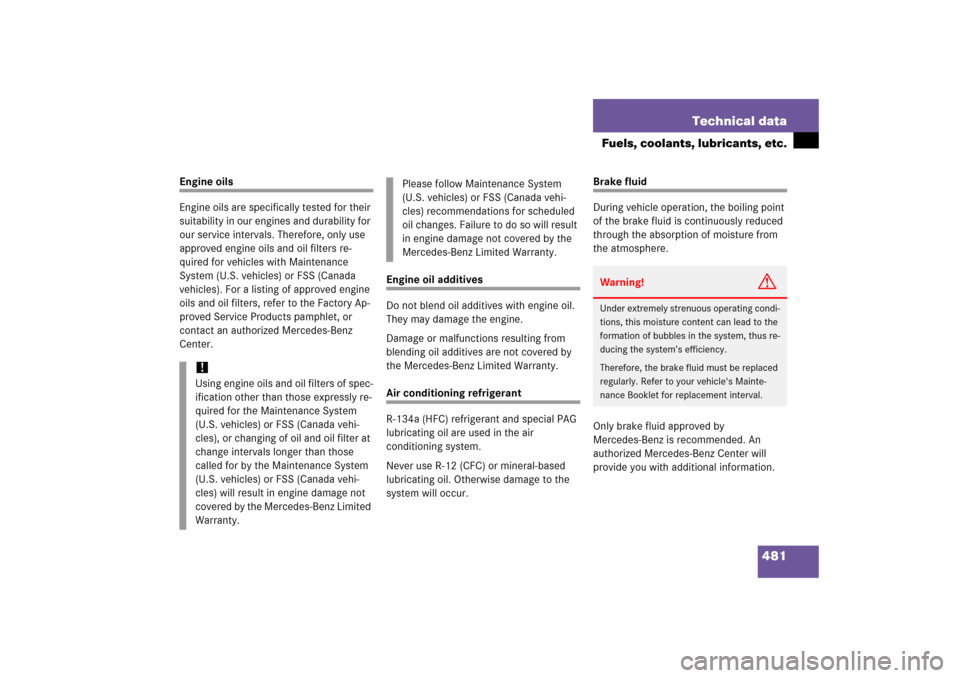
481 Technical data
Fuels, coolants, lubricants, etc.
Engine oils
Engine oils are specifically tested for their
suitability in our engines and durability for
our service intervals. Therefore, only use
approved engine oils and oil filters re-
quired for vehicles with Maintenance
System (U.S. vehicles) or FSS (Canada
vehicles). For a listing of approved engine
oils and oil filters, refer to the Factory Ap-
proved Service Products pamphlet, or
contact an authorized Mercedes-Benz
Center.
Engine oil additives
Do not blend oil additives with engine oil.
They may damage the engine.
Damage or malfunctions resulting from
blending oil additives are not covered by
the Mercedes-Benz Limited Warranty.Air conditioning refrigerant
R-134a (HFC) refrigerant and special PAG
lubricating oil are used in the air
conditioning system.
Never use R-12 (CFC) or mineral-based
lubricating oil. Otherwise damage to the
system will occur.
Brake fluid
During vehicle operation, the boiling point
of the brake fluid is continuously reduced
through the absorption of moisture from
the atmosphere.
Only brake fluid approved by
Mercedes-Benz is recommended. An
authorized Mercedes-Benz Center will
provide you with additional information.
!Using engine oils and oil filters of spec-
ification other than those expressly re-
quired for the Maintenance System
(U.S. vehicles) or FSS (Canada vehi-
cles), or changing of oil and oil filter at
change intervals longer than those
called for by the Maintenance System
(U.S. vehicles) or FSS (Canada vehi-
cles) will result in engine damage not
covered by the Mercedes-Benz Limited
Warranty.
Please follow Maintenance System
(U.S. vehicles) or FSS (Canada vehi-
cles) recommendations for scheduled
oil changes. Failure to do so will result
in engine damage not covered by the
Mercedes-Benz Limited Warranty.
Warning!
G
Under extremely strenuous operating condi-
tions, this moisture content can lead to the
formation of bubbles in the system, thus re-
ducing the system’s efficiency.
Therefore, the brake fluid must be replaced
regularly. Refer to your vehicle's Mainte-
nance Booklet for replacement interval.